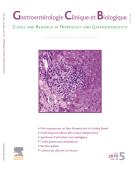Transplantation hépatique avec anastomose cavo-porte ou réno-porte - 29/02/08
Daniel Azoulay [1],
René Adam [1],
Denis Castaing [1],
Sorin Muresan [1],
Achile Essomba [1],
Eric Vibert [1],
Eric Savier [1],
Alaoua Smail [1],
Luc-Antoine Veilhan [1],
Henri Bismuth [1]
Mostrare le affiliazioniObjectif |
La thrombose diffuse du système porte était une contre-indication formelle de la transplantation hépatique jusqu'à l'utilisation récente des techniques de reperfusion portale du greffon par le sang cave inférieur. Les résultats à distance de notre expérience de ces techniques sont rapportés ici.
Malades et méthodes |
Huit malades avec thrombose portale diffuse ont été transplantés avec une reperfusion portale par anastomose latéro-terminale entre la veine cave native (2 malades) ou termino-terminale entre la veine rénale gauche native (6 malades) et le tronc porte du greffon.
Résultats |
Trois malades sont décédés 3, 3 et 6 mois après la transplantation d'hémorragie cérébrale, d'arrêt cardiaque et de rejet chronique respectivement. Trois malades ont eu des complications d'hypertension portale après la transplantation. Cinq malades sont vivants à domicile avec un recul médian de 9 mois (de 2 à 37 mois) avec des fonctions hépatique et rénale, une hémodynamique portale et une histologie hépatique normales.
Conclusion |
La reperfusion portale du greffon hépatique par le sang cave permet la transplantation jusqu'à présent récusée des malades avec thrombose portale diffuse. Des arguments en faveur de l'anastomose réno-porte sont apportés par notre expérience et par l'analyse de la littérature.
Liver transplantation with cavoportal or renoportal anastomosis: a solution in cases of diffuse portal thrombosis |
Objective |
Liver transplantation was contraindicated in patients with diffuse thrombosis of the portal vein until the recent use of graft portal vein reperfusion with the caval flow or one of its tributaries. Long term results of these procedures are reported here.
Patients and methods |
Eight patients with diffuse portal vein thrombosis were transplanted by portal reperfusion via latero-terminal anastomosis between the native caval vein and the graft portal vein (2 patients) or termino-terminal beween the native left renal vein and the graft portal vein (6 patients).
Results |
Three patients died 3, 3 and 6 months following transplantation from intracerebral hemorrhage, cardiac arrest, and chronic rejection respectively. Three patients had complicated portal hypertension. Five patients were alive at home with a median follow-up of 9 months (2 to 37 months) with normal liver and kinase functions.
Conclusion |
Portal reperfusion with the caval vein flow allows tranplantation of patients with diffuse poral vein thrombosis. According to our experience and to the analysis of the literature, reno-portal anastomosis is preferable to cavo-portal reconstruction.
Mappa
© 2002 Elsevier Masson SAS. Tous droits réservés.
Vol 26 - N° 4
P. 325-330 - Aprile 2002 Ritorno al numeroBenvenuto su EM|consulte, il riferimento dei professionisti della salute.

